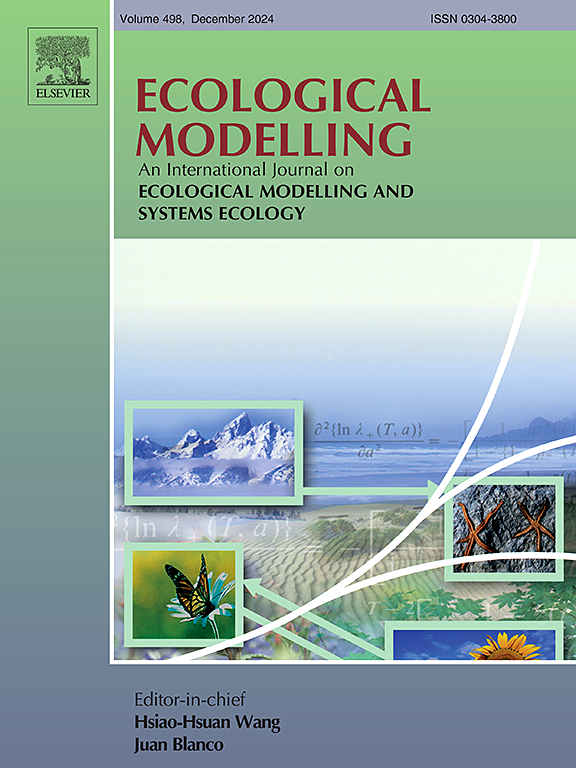Quantile regression for estimating Douglas-fir natural regeneration potential using the R package quaxnat: Advanced ecological modeling for the management of nature conservation and silviculture
IF 2.6
3区 环境科学与生态学
Q2 ECOLOGY
引用次数: 0
Abstract
Recent extreme weather conditions in Europe have led to widespread destruction of Norway spruce by storms and bark beetles, creating large clearings that need replanting. The shortage of planting material has shifted focus to natural regeneration processes, with Douglas-fir (Pseudotsuga menziesii [Mirb.] Franco) emerging as a potential substitute due to its growth performance and drought tolerance. This study introduces and applies methods for investigating the regeneration ecology of Douglas-fir, focusing on the potential density of established regeneration and its dependence on the distance to the nearest seed source.
This dependence is modelled with various classical spatial dispersal kernels, the parameters of which are estimated with a quantile regression approach implemented in a new R package quaxnat. Regeneration data from 44,257 sample plots in the state forest of Lower Saxony, Germany, are combined with remote sensing-based positions of potential seed trees to illustrate these methods. Among the standard dispersal kernels provided by quaxnat, the spatial t distribution proves to be the most suitable. Here, for the .999th quantile, the estimated potential regeneration density reaches almost 11,000 trees per hectare in the immediate vicinity of the seed trees and decreases sharply with increasing distance.
A simple simulation model that takes dispersal and establishment into account illustrates how these results can be linked to management scenarios. The study provides valuable information for nature conservation and silviculture, suggesting buffer zones around sensitive habitats and guiding forest management decisions regarding natural regeneration options.

使用R包quaxat估计道格拉斯冷杉自然更新潜力的分位数回归:自然保护和造林管理的高级生态模型
最近欧洲的极端天气条件导致挪威云杉被风暴和树皮甲虫大面积破坏,造成大面积的空地需要重新种植。种植材料的短缺已经将重点转移到自然再生过程上,道格拉斯冷杉(pseudosuga menziesii) [Mirb。[Franco])由于其生长性能和耐旱性而成为潜在的替代品。本文介绍并应用了道格拉斯杉木更新生态学的研究方法,重点研究了已建立更新的潜在密度及其与最近种子源距离的关系。这种依赖关系是用各种经典的空间分散核来建模的,其中的参数是用一个新的R包quaxnat实现的分位数回归方法来估计的。来自德国下萨克森州44,257样地的更新数据与基于遥感的潜在种子树位置相结合,以说明这些方法。在quaxnat提供的标准分散核中,空间t分布被证明是最合适的。在0.999分位数,种子树附近的潜在更新密度达到1.1万棵/公顷,随着距离的增加而急剧下降。一个将分散和建立考虑在内的简单模拟模型说明了这些结果如何与管理方案联系起来。该研究为自然保护和造林提供了有价值的信息,建议在敏感栖息地周围建立缓冲区,并指导有关自然更新选择的森林管理决策。
本文章由计算机程序翻译,如有差异,请以英文原文为准。
求助全文
约1分钟内获得全文
求助全文
来源期刊

Ecological Modelling
环境科学-生态学
CiteScore
5.60
自引率
6.50%
发文量
259
审稿时长
69 days
期刊介绍:
The journal is concerned with the use of mathematical models and systems analysis for the description of ecological processes and for the sustainable management of resources. Human activity and well-being are dependent on and integrated with the functioning of ecosystems and the services they provide. We aim to understand these basic ecosystem functions using mathematical and conceptual modelling, systems analysis, thermodynamics, computer simulations, and ecological theory. This leads to a preference for process-based models embedded in theory with explicit causative agents as opposed to strictly statistical or correlative descriptions. These modelling methods can be applied to a wide spectrum of issues ranging from basic ecology to human ecology to socio-ecological systems. The journal welcomes research articles, short communications, review articles, letters to the editor, book reviews, and other communications. The journal also supports the activities of the [International Society of Ecological Modelling (ISEM)](http://www.isemna.org/).
 求助内容:
求助内容: 应助结果提醒方式:
应助结果提醒方式:


